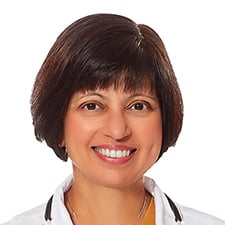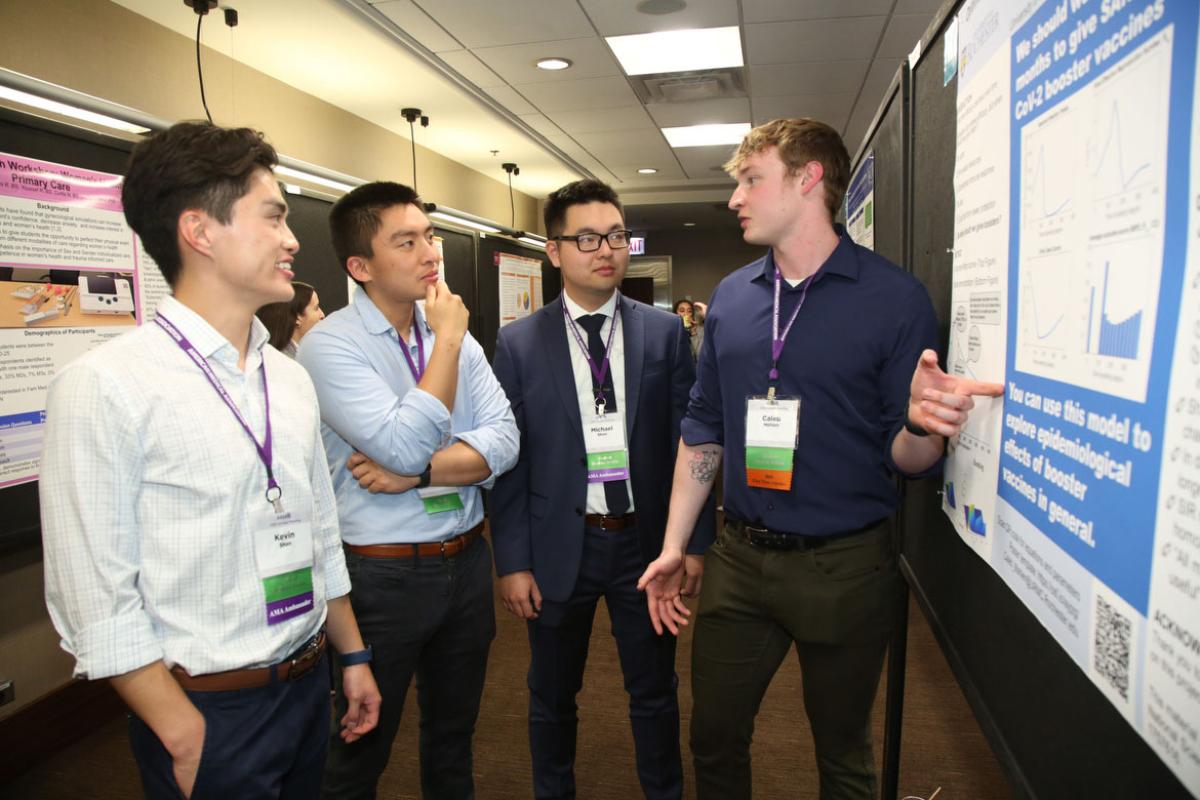As a medical student, do you ever wonder what it's like to specialize in radiation oncology? Meet Sheila Rege, MD (@SheilaRegeMD), a radiation oncologist and a featured physician in the AMA's "Shadow Me" Specialty Series, which offers advice directly from physicians about life in their specialties. Check out her insights to help determine whether a career in radiation oncology might be a good fit for you.
The AMA's Specialty Guide simplifies medical students' specialty selection process, highlight major specialties, detail training information, and provide access to related association information. It is produced by FREIDA™, the AMA Residency & Fellowship Database®.
Learn more with the AMA about the medical specialty of radiation oncology.
"Shadowing" Dr. Rege
Specialty: Radiation oncology.
Practice setting: Group practice in Kennewick, Washington.
Employment type: Employed by group.
Years in practice: 23.
A typical day and week in my practice: A typical day starts with a team huddle to review patients undergoing daily radiation—typically, patients have daily weekday treatments for two to six weeks)—as well as review patients that were hospitalized or seen in the ER overnight and go over our clinic schedule. Once a week, we have a formal, hour-long discussion and review called “chart rounds,” where a team—physician, physicist, therapist, nurse, nurse navigator and front-desk worker—discuss each patient and their needs. Sometimes we have medical students or residents, so we assign roles for them.
Usually, patients begin coming into the clinic, depending on volume, around 8 a.m., and then it’s showtime. In the radiation oncology department, it’s truly a team-based approach. The team works like an orchestra, with each person understanding their strengths and when to call for help. I have been fortunate to have an assistant who is truly amazing. Patients love her and she works magic with prior authorizations while also helping me stay on task in terms of getting back to patients, addressing family issues, etc.
Our clinic has been fortunate in having the latest technology, so patients are able to review their imaging on a screen facing them that has the same images I am viewing. This means they can follow along with me and actually see what I mean when I say, “Look, that’s scar tissue.” The funniest moments are when patients read their reports and take exception to phrases we take for granted, such as “breasts are dense,” “exam is unremarkable,” “age-related white matter changes in brain” or “degenerative changes.” I have had a few patients ask for the radiology report or referring doctor’s note to be rewritten.
The most challenging and rewarding aspects of radiation oncology: Radiation oncology is both challenging and rewarding. I am always amazed at the strength patients display when facing cancer, which in some cases may be a death sentence. Patients have taught me how to ignore the little things and to enjoy life because each day may be our last.
I recall that I had a patient who had “shopped” around for doctors when he was diagnosed with a head and neck cancer. He lived in our town and had a choice of a few radiation oncologists. He also had family in a bigger city and had seen three radiation oncologists there. Head and neck cancers are relatively fast growing, and we like to begin radiation four to six weeks after surgery.
He saw me at four weeks, and I told him that even the best doctor would have a hard time helping him beat the odds to cure his cancer if he delayed beginning radiation for more than a week. I was blunt with him and told him he just needed to pick one doctor and start treatments. To my surprise, he called back the next day to say he was getting his treatments at our clinic. He had a low pain threshold and had a lot of side effects with treatments, but we as a team were hypervigilant and made sure he stayed out of the hospital while receiving chemoradiation. Studies have shown that any days off treatments—due to treatment breaks or delays—reduce the cure rates.
At his one-year visit after completion of treatment, his wife confessed that she thought I had been unduly hard on him with insisting on continuing radiation despite how poorly he was doing. Our team was aggressive about support therapies including intravenous hydration, etc. We have access to a great nutritionist, an occupational therapist and a physical therapist, all of whom are great parts of our team. We were hands on and got him through the tough times.
How life in radiation oncology has been affected by the global pandemic: The pandemic has affected my life because I miss hugs, visiting my elderly mother and going out. However, it is humbling to see patients face cancer treatments that reduce their immunity, make them lose their hair, etc., and be isolated because of the pandemic. If they can keep their spirits up while dealing with this adversity, then I have no reason to complain.
The long-term impact the pandemic will have on radiation oncology: We are all struggling to adapt and understand what health care will look like in the post-COVID world. I know my patients love to come in to celebrate their first, second, third or, most important, fifth anniversary after cancer treatments—they even bring their families—and we make it special for them. It is helpful to release the imaging and lab findings to them on the portal prior to their visit. We have a bell they ring to celebrate end of treatment or a major milestone on their cancer journey.
I think we will have more telehealth but patients may still choose to come in to celebrate. Some have made cakes and jewelry for our staff or knitted gifts for their children or grandchildren, but we ask that patients try not to “gift” us or our staff and limit the amounts, and the same applies to staff making special gifts for patients to celebrate important milestones. It seems to me that most radiation oncology departments have been ahead of the curve in developing strong teams to help support patients through their cancer journey.
Three adjectives to describe the typical radiation oncologist: Caring, intuitive and computer savvy. A lot of our time is spent with technology—sculpting beam shapes, which is heavy on physics, and analyzing 3D images.
How my lifestyle matches, or differs from, what I had envisioned: I began my career thinking I wanted to be a surgical oncologist, then I did a fellowship in positron emission tomography and switched to radiation oncology. My personal purpose has always been to help cancer patients, and I finally found a field that aligns with this personal purpose while allowing me to enjoy patient interaction and develop long-term relationships with my patients. I have a patient who has stayed in touch every year for the past 20 years.
I enjoy the cards and calls from “cancer survivors” who have “graduated from my clinic.” Radiation oncology is good for work-life balance because we don’t have many emergencies. However, patients do schedule their follow up appointments at six-month or 12-month intervals, and the joy on their faces when they see the doctor who treated them is indescribable. That means I have missed many weddings and birthdays because I knew a patient would have been crushed to not see me on their five-year anniversary or any other. So, unlike some other fields that allow shift work, in radiation oncology the long-term relationship with patients brings the most satisfaction, but it also means you have to plan your vacation time carefully and give up some flexibility for last-minute changes.
Skills every physician in training should have for radiation oncology but won’t be tested for on the board exam: I had always thought I was a good doctor and had many positive patient comments. However, after my father passed away, a patient told me that I had changed. I think what he meant was that I was more empathetic and more patient. Facing cancer is tough, and physicians need to be patient to allow patients to process this life-changing diagnosis, because most patients will never return to the old normal but will instead have to adjust to a new normal.
Also, having a good sense of humor and being able to look on the bright side are important. I remember one patient who came in jaundiced but was otherwise happy. The front desk staff and nurses could not understand her upbeat mood.
I went into see her, and she chuckled and said, “You said I’d know when the end was near because I’d turn yellow or cough up a lot of blood. Well, I’m yellow and I still feel great. I look like the sunflowers that I love. I’m so glad the liver lesions are getting me and not the lung ones!”
I looked her in the eye and said, “You beat the odds, correct? I guess the stats were wrong because you thought you had six months, remember? And that was what—three years ago? Remember when I asked you if you came stamped with an expiration date?”
We both recalled her initial diagnosis. She then introduced me to her daughter, who had been estranged from her, and said, “My daughter doesn’t understand why I am so happy.”
One question physicians in training should ask themselves before pursuing radiation oncology: We do have a fair number of patients who succumb to cancer. For some people, this might be depressing, but I’ve found it a rather motivating factor—it has inspired me to live life fully. Physicians in training need to be comfortable with patients in the final months of their lives.
I believe my greatest gift has been to be with a patient while he or she has faced end-of-life issues, to see them at the hospital and discuss do-not-resuscitate orders or other end-of-life matters, and to be there during their final moments. Patients and their families need us to be with them during the good times and the bad.
Books every medical student interested in radiation oncology should be reading:
- When Breath Becomes Air, by Paul Kalanithi, MD.
- Black Man in a White Coat: A Doctor's Reflections on Race and Medicine, by Damon Tweedy, MD.
- The Real Doctor Will See You Shortly: A Physician’s First Year, by Matt McCarthy, MD.
All of these books helped me understand the doctor-patient relationship, how and why it's sacred and how important the trust and bond between us is.
The online resource students interested in radiation oncology should follow: Mentors are the resource I have always benefitted from the most, and the mentors I had in medical school were different from the ones I had in residency or early practice years. I still have mentors and also a group of supportive professionals who I can reach out to during my successes and also my failures. We talk, we share insights on the best online resources or social media pages, etc. My advice is to get mentors and meet with them at least once a quarter.
Quick insights I would give students who are considering radiation oncology: Shadow a radiation oncologist so you can see what their day-to-day life is like. Meet the patients, meet the team and decide if the fit is right—in terms of both the culture and the skills required. Radiation oncology requires good math skills and physics skills, as well as great bedside manners.
Mantra or song to describe life in radiation oncology: Since I am tone deaf, this is tough. My personal favorite is an odd-duck poem by Paul Laurence Dunbar, written in 1913: “Keep A-Plugging Away.”




